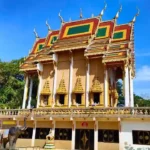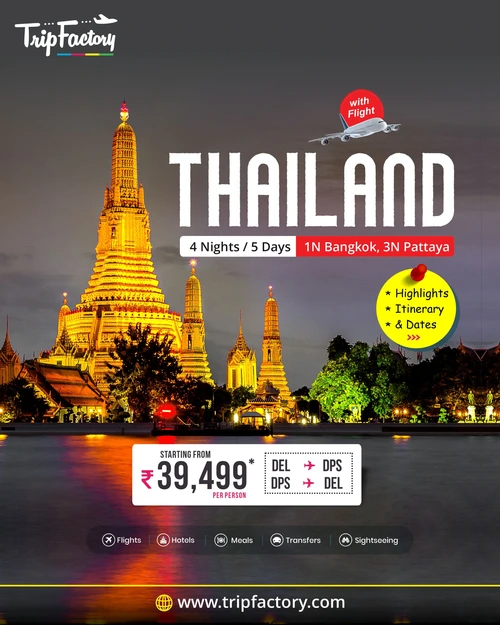It is one of Koh Samui’s most beautiful and important temples. The name comes from two Thai words: “Sila,” which means “stone,” and “Ngu,” which means “snake.” This name describes both the temple’s physical and symbolic parts. The temple grounds have winding paths, bright red clay tiles and snake-like patterns throughout the building. These things remind me of the Naga serpent, a guardian and protector in Thai and Southeast Asian Buddhist mythology.
Some temples only have golden Buddha statues or fancy rooflines, but Wat Sila Ngu combines physical art with deep spiritual meaning. The Naga serpent is seen as a protector of treasures and a keeper of Buddha’s teachings. This idea is reflected in the temple’s layout, carvings, and statues. As soon as you get close to the temple, you can tell that this is a place where art, architecture, and spirituality all come together. Visitors to Wat Sila Ngu will find a peaceful place to think, meditate, and learn about Thai Buddhist culture. People from the area come to the temple to pray and do good deeds, and people from other countries come to see its bright colours, beautiful coastal setting, and historical importance.
History of Wat Sila Ngu
Wat Sila Ngu was built in the early 1900s and has since become an important part of Koh Samui’s spiritual life. Over the years, the temple has changed by adding more land, building new shrines, and keeping the old ones in good shape to protect its history. Thai and Buddhist mythology give it its name and meaning. The Naga, or snake god, is linked to safety, knowledge, and protection. The snake symbolism at Wat Sila Ngu goes beyond myth and into the temple’s physical features. For example, the red-tiled outside, the stairs that go up and down, and the snake-like patterns all visually echo how the snake moves.
The temple has also taken in artistic ideas from Chinese Buddhism over time. Modern Thai Buddhist temples are known for their multicultural spiritual environments, which include smaller shrines to Guan Yin, the Goddess of Mercy, and other respected deities and monks.The underground meditation room at Wat Sila Ngu is a very special feature. It is only for spiritual practices and religious ceremonies. This room shows that the temple is not only a place to worship, but also a safe place to think, meditate, and practise mindfulness.
Location, Directions & Timings
Wat Sila Ngu is in Ko Samui, Surat Thani Province, Thailand. It is in a beautiful spot that looks out over the island’s blue waters and lush tropical plants. The view from up here is amazing, and it adds to the sense of peace and spiritual immersion that visitors feel when they arrive. The temple is close to other popular places to visit, like Lamai Beach, Big Buddha Temple (Wat Phra Yai), and Wat Plai Laem. This makes it easy to add to a cultural day tour of the island.
People can get to Wat Sila Ngu by car, motorbike, or as part of a tour. Wat Sila Ngu is open from 7:00 a.m. to 6:00 p.m. Early mornings are very peaceful. You can see monks chanting in the morning, locals doing good deeds, or the golden sunlight shining off the Buddha statues and red-tiled roofs.
Things to See and Do in the Wat Sila Ngu
- Look at the Golden Buddha: The beautiful golden Buddha in the Subduing Mara pose in the middle of Wat Sila Ngu represents the moment he became enlightened. In this pose, the Buddha is calling the Earth to see him win over temptation, which is a sign of spiritual victory. The statue is impressive in both size and detail. The carvings bring out the folds in the robe, the calmness of the face, and the delicate positioning of the hands.
- Look at the murals and carvings: There are beautiful murals and carvings all over the temple that show scenes from Jataka tales, Buddhist teachings, and the lives of famous monks. Lotus flowers stand for purity, Bodhi trees stand for enlightenment, and serpentine patterns stand for the Naga guardian. Looking at these works of art can help you understand Buddhist philosophy and Thai cultural symbols.
- Go to smaller shrines: There are a number of smaller shrines at Wat Sila Ngu, one of which is dedicated to Guan Yin, the Goddess of Mercy. People who are looking for compassion, guidance, or spiritual comfort often stop here to pray. Some shrines honour local monks or gods from Chinese Buddhist traditions, which shows how different spiritual traditions have come together.
- Look around the Underground Meditation Chamber: The underground meditation chamber is a hidden gem at Wat Sila Ngu. This area is only for ceremonies, meditation, and quiet thought. You will feel very calm as you walk through it, away from the busy main grounds of the temple. This is a great place to think about yourself and do mindfulness exercises.
- Watch what the monks do every day: The kuti, or monk’s dwelling, is next to the main temple. Monks live there and do their daily rituals there.
- Taking pictures and learning about other cultures: The temple’s bright red walls, golden statues, and lush surroundings make it a great place for photographers. Take pictures of the strong differences, but be respectful, especially near the Buddha statues and during ceremonies.
- Walking slowly and enjoying nature: There are lots of gardens and trees on the temple grounds, which are very big. Walk slowly, listen to the leaves rustling softly, and feel the calm energy of the place.
Tips Before you visit the Wat Sila Ngu
- Dress modestly by covering your knees and shoulders and not wearing sleeveless tops or short shorts.
- Before you go into holy places like the main Buddha hall and shrines, you must take off your shoes.
- Don’t touch statues of Buddha or ritual items, and be quiet.
- Don’t use flash near sacred objects, and be respectful during ceremonies.
- Learn about the culture by watching monks chant or do rituals.
- Bring water and sunscreen with you, especially if you’re going to the temple in the middle of the day.
- Think about hiring a local guide or going on a temple tour to learn more about the symbolism, murals, and cultural context.
FAQs on Wat Sila Ngu
It means “Stone Snake Temple,” which is a name that fits both the temple’s physical features and the spiritual meaning of the Naga serpent as a protector of Buddha’s teachings.
Yes. The temple’s large grounds, bright statues, and peaceful atmosphere make it a good place for families to visit. Kids can feed the fish in ponds (if there are any) or watch cultural events with respect.
Yes. There is an underground meditation room for ceremonies and reflection, and guests are welcome to meditate quietly in certain areas outside or inside the main hall.
There are no set fees, but donations to help with the upkeep of the temple and the monks are welcome. Even small gifts are seen as a sign of respect.









